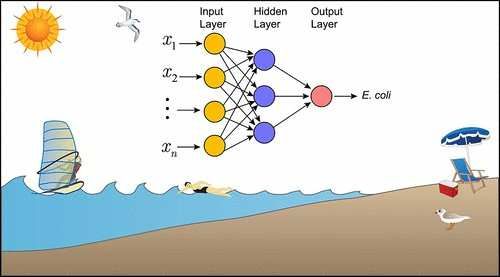Computer Models Provide Accurate Short-term Forecasts of Beach Water Quality
Published on by Water Network Research, Official research team of The Water Network in Technology
Researchers reporting in the ACS journal Environmental Science & Technology have identified computer models that provide accurate short-term forecasts, or “nowcasts,” of beach water quality.
Arriving at your favorite beach only to discover it’s closed because of bacterial contamination can be a bummer. But even worse would be unknowingly swimming in waters polluted with fecal material — a very real possibility, given that current detection methods can require up to 24 hours to obtain results. Now, researchers reporting in the ACS journal Environmental Science & Technology have identified computer models that provide accurate short-term forecasts, or “nowcasts,” of beach water quality.

Credit: American Chemical Society
The number of beach closings due to fecal microbes has risen in recent years. In the U.S., beaches in the Great Lakes region rank high among those with the worst problems. According to the Michigan Department of Environmental Quality, 30 beaches in the state were either closed or had advisories associated with them in early July 2018 because of high bacteria levels. Collecting water samples and then analyzing them in the lab takes time, even with modern techniques, which puts swimmers at risk of infection with nasty stomach bugs while testing is ongoing. But computer simulations for predicting water quality are complex and not always reliable. Jie Niu and Mantha S. Phanikumar wondered if they could identify simpler computer models that could accurately predict current beach conditions from past data.
The researchers compared the abilities of five computer models to nowcast bacterial levels at four sites in Southern Lake Michigan. The models varied in the number of input parameters, from only past levels of bacteria at the sites, to more complex data, such as daily rainfall, water temperature and water turbidity. The team found that the two best models incorporated past bacterial levels and several of the other parameters. However, a new model developed by the researchers also performed well. This approach, which combined two techniques called wavelet transform and artificial neural network analysis, required only bacterial data from the past, with no additional inputs. The researchers concluded that the new model is a potentially useful tool for beach management, especially when detailed data on beach conditions aren’t available.
The authors acknowledge funding from the National Natural Science Foundation of China.
Source: ACS
Media
Taxonomy
- Standards & Quality
- Quality
- Water Quality
- Marine
- Quality Maintenance
- Oceanographic Survey
- Water Quality Monitoring
- Marine Technologies
- Water Software
- Water Quality Research
1 Comment
-
Hi. Researchers. Comp models are best for diagonastic assmnt of solutions.remedials.after-effects at site. All data to be well compiled, applied with a few factors, inference etc. True on site findings and variances in data to be kept note.correction done. Well wishes from Prof Ajit Seshadri. Vels University.Chennai.INDIA.